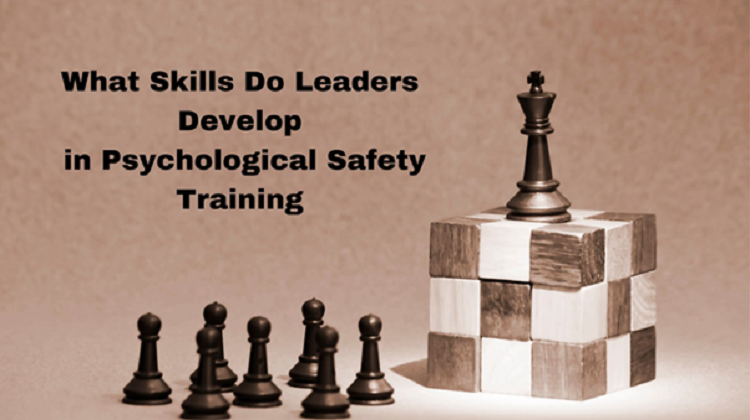An ideal workspace should be inclusive, supportive, and growth-oriented. Here, ideas should naturally soar, trust should flow effortlessly, and uniqueness should be celebrated collaboratively. This underscores the significance of psychological safety training for leaders prompting the question, ‘As a leader, are you equipped with enough skills to foster such an environment?’.
Whether you are an HR professional, team lead, manager, or emerging leader, We understand the challenges in shaping a high-performing team. Deal the problems with psychological safety training, a dynamic approach to empowering leaders from all walks of life with essential skills.
10 Skills Leaders Develop in Psychological Safety Training
Engaging Communication
In a psychologically safe workplace, the leader asks, ‘Tell me about your progress. This encourages deeper understanding and meaningful conversations. Open-ended questions and active listening are crucial in fostering an environment where team members feel free, valued, and respected. They develop a sense of belonging as their opinion matters, enhancing team performance.
Embracing Failures
We are all used to single-loop learning which is about making adjustments to correct a mistake. It focuses on doing things right. In contrast, double-loop learning goes deeper, addressing the issue and fixing the root cause. It opens the door for innovation. But double-loop learning thrives only in a psychologically safe environment where you can make mistakes.
You want zero hiccups while exploring something new. As a leader, it is crucial to change the outlook towards mistakes. Reframe them as learning opportunities. Help your team members point out and correct their mistakes. Let them experiment and grow.
Encouraging Diverse Voices
Sunflowers instinctively face the sun for light. In a team, when team members tell only what the leader wants to hear, not their thoughts or truth, it’s like the leader is the sun and the team members are the sunflowers. This ‘sunflower effect’ hinders innovation.
To deal with this, encourage team members to share their thoughts openly. Keep reminding them that the leader doesn’t have an answer for all. Appreciate their contributions, big or small. Before making a decision, genuinely ask, ‘Are we good to go?’ Be transparent about the decision-making process. Tell why their ideas are not incorporated if not.
Enabling Innovation
For transformative growth and progress, enabling innovation is the key. In a psychologically safe workspace, the leader gives the team the authority and power to develop new ideas. Unleash the team’s potential by encouraging diverse perspectives.
Empathy and Emotional Intelligence
Gone are the days of rigid and unfeeling authority. Today’s leaders are empathetic professionals with emotional intelligence who are kind, understanding, and humane.
Go beyond being just a boss. Be a bit vulnerable. In “The Best Leaders Aren’t Afraid to Be Vulnerable,” Omadeke says that being vulnerable can look like the leader advocating for equal pay for team members or addressing a traumatic or sensitive issue.
Establishing Clear Goals
Establishing clear goals and managing expectations is crucial in maintaining a psychologically safe environment. Set challenging targets to avoid burnout. Seek feedback and give feedback regularly.
Effective Decision Making
A study by McKinsey found that diverse teams that feel psychologically safe are 87% more likely to make better business decisions. Leaders trained in psychological safety are easy with the ‘what should you do’ mindset. Focusing on proactive solutions, they boldly face challenges that come the way, ensuring a psychologically safe environment for the team.
Effective Conflict Resolution
Disputes are inevitable in a team. As a leader, you cannot ignore it or think it will pass because it has nowhere to go. In case of conflicts, take decisive action immediately, involving all parties in open communication. Facilitate effective communication by choosing a suitable location. Listen to them actively and find the right and unbiased solution after thoroughly understanding the issue.
Empowering Teamwork
According to the American Psychological Association, teamwork increases productivity by 25%. Acknowledging this, the leader conducts brainstorming sessions, cross-functional collaborations, and knowledge-sharing activities to foster a psychologically safe workspace. Through this, the team’s diversity is celebrated, helping team members better understand each other.
Exemplifying Ethical Leadership
We all are conditioned to certain thoughts and beliefs. Before carrying it to the workspace, a leader should check on these, for they could be harmful and sometimes even discriminatory.
Ethical leader exemplifies themselves by prioritizing integrity, honesty, and doing what is right. With every ethical decision, one earns the respect and trust of the team. Ethical leadership brings positivity to the workspace, and bears hope for a compassionate future.
Conclusion
Through psychological safety training, leaders develop essential skills like engaging in communication, embracing failures, encouraging diverse voices, enabling innovation, empathy, and emotional intelligence, establishing clear goals, effective conflict resolution, empowering teamwork, and exemplifying ethical leadership.
These skills are essential because, as statistics reveal, employees are more likely to quit their job if they are unsatisfied with their leader or manager. Google’s ‘Project Aristotle,’ a dynamic study on team productivity that revealed psychological safety as the most significant factor contributing to high-performance teams, further re-emphasizes its importance. Acquiring these skills lays the foundation for remarkable achievements in the modern workplace.
Frequently Asked Questions
Does psychological safety negatively impact accountability in a team?
Psychological safety and accountability are not mutually exclusive and can co-exist harmoniously. Psychological safety training empowers team members to take ownership and be accountable for their mistakes, enabling them to rectify and learn from them.
How can leaders assess psychological safety within the team?
The frequency of each team member speaking up, sharing ideas, giving feedback, etc., can be considered as an indicator to measure psychological safety within the team. To assess these aspects, you can conduct surveys, brainstorming, and feedback sessions.
How does psychological safety training impact team productivity?
It is proven that psychological safety training enhances team productivity. Leaders trained in psychological safety empower the teams with higher engagements, innovations, and improved performance.



